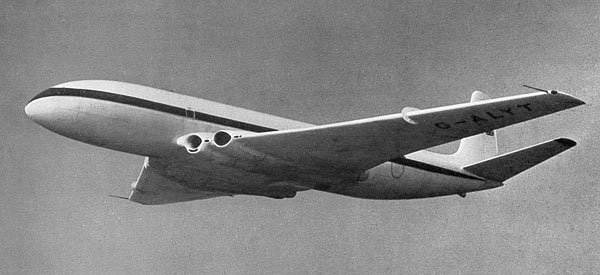
Comet 2
Rolls-Royce started work on Britain's first axial-flow jet engine in 1945. It was selected for the Comet and for the Avro Canada C102 Jetliner. Engine delays resulted in the C102 being cancelled, but de Havilland had hedged their bets, developing a more powerful version of their own Ghost centrifugal engine for the Comet 1.
The Comet Series 2, with four Rolls-Royce Avon engines, made its first flight on 27 August 1953, for introduction in 1954. It had 46% more thrust, increasing maximum weight to 120,000 lbs. and passenger numbers from 36 to 44. It had increased range, reduced operating costs, and opened new routes for jet travel. By end of 1953, 35 Comet 2s had been ordered by 8 airlines.
The 1954 disasters stopped everything. Production of the Series 2 had been in full swing with 25 aircraft in various stages of assembly. All commercial orders were cancelled.
After the inquiry, an assessment was made about how to salvage the Series 2. De Havilland, with support from the RAE, prepared a package of modifications to upgrade the aircraft to proper strength and deal with a number of peripheral concerns. Changes included re-skinning the fuselage, extensive structural reinforcement, oval cabin windows, and directing the engine exhaust away from the fuselage. Assembled aircraft were deemed too expensive to modify completely, and were re-certified for unpressurised use only. In total, 15 out of 25 Comet 2s were saved, 8 of which were fully modified.
All serviceable Comet 2s (and two modified Comet 1XBs) went to the Ministry of Supply, 13 being redistributed to the RAF, who unexpectedly found themselves with the largest fleet of military jet transports in the world. As a result, they were used for all kinds of tasks at home, or "wet" leased abroad. A Comet, flown by de Havilland test pilot Ron Clear, and equipped as a flying laboratory for calibrating de Havilland's Blue Streak rocket, flew to America to assist the USAF with their own air-to-air missile system at Edwards Air Force Base. It also monitored the heat signatures of ICBM rockets launched from Cape Canaveral.
The last Comet 2 was retired from service on 10 January 1975.
